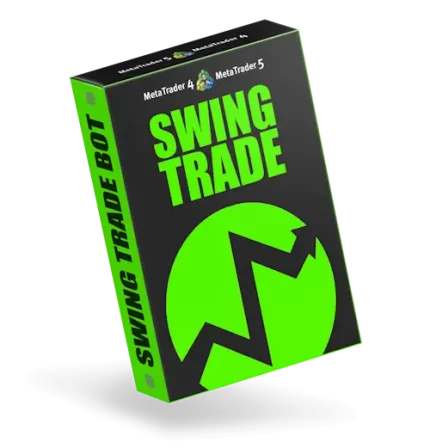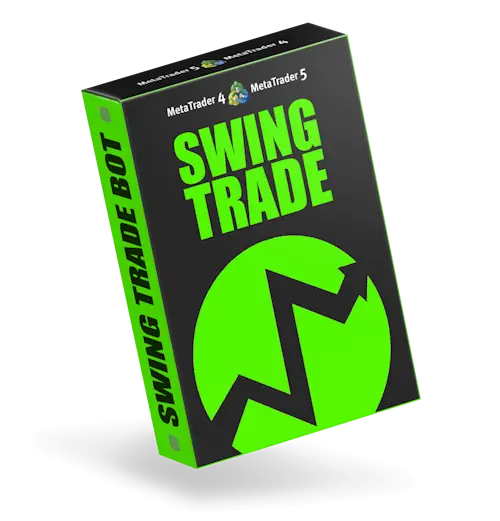

Artificial Intelligence Inside
Introducing Swing Trading software, which uses the Google Bard and ChartGPT networks to analyze the market and find the best levels for trading.
Swing Trade Bot uses a unique local swing trading strategy, which gives high performance with minimal trading drawdown. Have you dreamed of finding a bot that works within 5% max DD? So you found it!
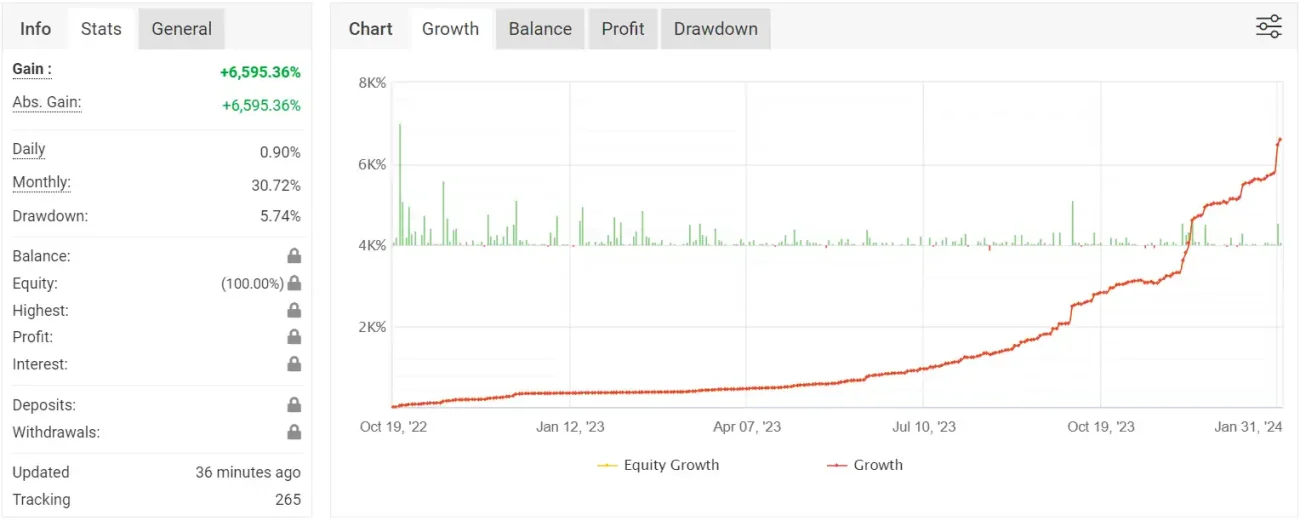
+6 595 % growth - verified real result
Swing Day Trading bot Able to work with the following systems:
Swing Trading System
- Maximum 1 trade at a time
- 10 assets to trade
- Day trading strategy - "Local swing reverse"
- Without averaging and without martingale
- Each deal is protected by Stop Loss
- Timeframe for trading - H1
Trend Trading System
- Maximum 2 trade at a time
- 7 assets to trade
- Day trading strategy - "Trend reversal"
- Without averaging and without martingale
- Each deal is protected by Stop Loss
- Timeframe for trading - H1
Local Martingale
- Maximum 2 trade at a time
- 3 assets to trade
- Day trading strategy - "local swing reverse"
- Martingale and averaging (no more than 2 trades)
- Each deal is protected by Stop Loss
- Timeframe for trading - H1

Reversal Grid System
- Maximum 10 trade at a time
- 5 assets to trade
- Day trading strategy - "local swing reverse"
- Averaging without martingale
- Timeframe for trading - H1
How does SWING TRADE BOT trade on the quote chart window?

Our software complies with strict regulations
- Complies with Prop Firm rules
- Complies with FIFO rules
- 1:30 leverage is enough
- All deals are protected by Stop Loss
Developed for the most popular platform:


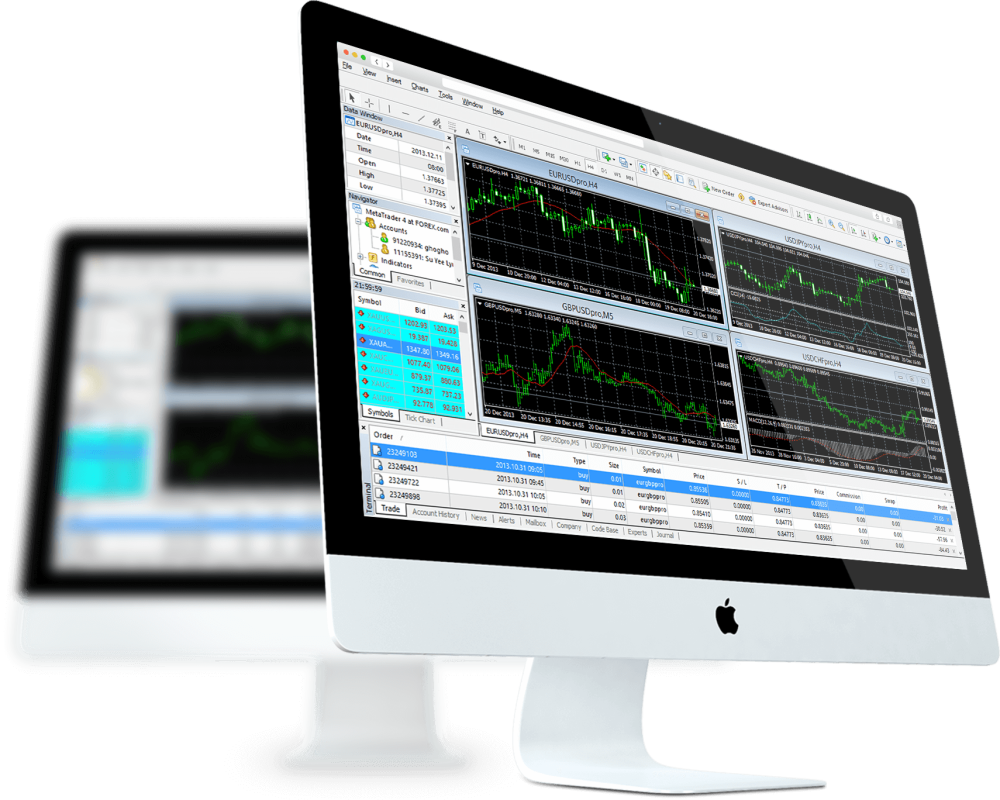


AI Swing Trading EA
+6 595 % growth - verified real result
Swing Trading EA is a multi-currency bot (MT4 + MT5) for trading using the Swing Reversal strategy (uses 4 strategies). 10 assets to trade. Verified by MyFxbook. Prop Firm passed.- Swing Trading EA for MT5
- Swing Trading EA for MT4
- Lifetime license without subscription
- The number of licenses is unlimited
- Settings (set files) for maximum performance
- Detailed instruction – how to install and use
- Technical support
How does this work in the automatic strategy tester?
Up to 1 million. Trade on just 1 asset (you can use a total of 8 assets at the same time). That is, multiply this result by 8!

Artificial Intelligence Inside
How was the automated trading system Swing Trade Bot created?
We have created an automatic trading system for swing reversal trading using ChartGPT and Google Bard neural networks. Note - these systems can automatically analyze market data, identify potential swing reversal points, and create trading rules for compiling a trading strategy. Read more about how the process of creating our Day trading strategy Swing went below:
- Data Collection and Preprocessing
- Data collection: Initially, using the ChartGPT and Google Bard neural networks, we gathered historical market data, including closing prices, trading volumes, as well as technical indicator data such as moving averages, RSI, MACD. These significantly assisted in the analysis of the historical data on swing reversals we collected over the last 10 years.
- Data preprocessing: Utilizing the power and incredibly large analytical capabilities of the ChartGPT and Google Bard networks, we cleaned the collected technical analytics from unnecessary "noise" and omissions, normalized this database to improve the neural network training process, and divided the obtained database into training and technical samples.
- Feature and Label Definition
- Features: We identified key features from historical data that we planned to use for forecasting in the future. These were price patterns, technical indicators, and other relevant metrics.
- Labels: Each data sample was assigned a label indicating the presence of a swing reversal. A binary classification was used, where "1" denotes a swing reversal, and "0" indicates its absence.

- Neural Network Architecture Selection
- Architecture: We selected a suitable neural network architecture for the forecasting task. For analyzing time series, we used recurrent neural networks (RNN), specifically LSTM (Long Short-Term Memory) or GRU (Gated Recurrent Unit), as well as convolutional neural networks (CNN) for identifying patterns in the data.
- Model Training
- Training: We conducted training of the neural networks on the prepared dataset, minimizing the error between predicted and actual label values. During the training process, it's important to control overfitting by using regularization techniques and validation.
- Testing and Validation
- Testing: After training, the identified trading network model was tested on a separate dataset to assess its ability to generalize and predict swing reversals on unseen data.
- Validation: We used additional model validation in real trading conditions on historical data using backtesting.
- Integration with Trading Platform
In conclusion of the process, we integrated the trained model into the code that can operate with the trading platform, allowing it to automatically execute trading orders of our trading system.
Thus, as a result of a sufficiently labor-intensive process, the Swing Trade Bot was created.
How does the Swing Trade automated bot strategy work?
Determines support and resistance levels
Bot for automated trading Swing, using an algorithm created by a neural network, identifies key levels of support and resistance on the asset chart window:
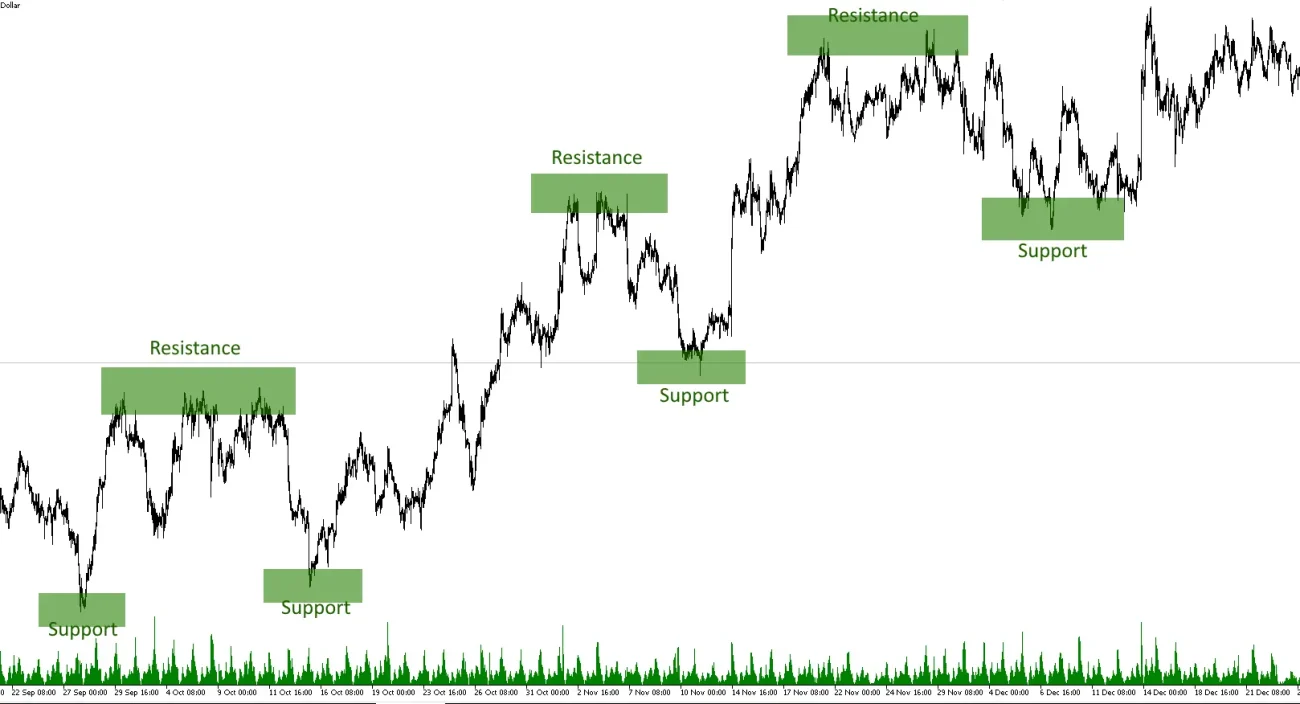
Finds swing reversal patterns and price channel
Next, using a special algorithm, our bot for automatic trading identifies Swing patterns (that is, moments of local and global price chart reversals). Also, using a special indicator, Swing trading Bot finds the boundaries of price movement (determines the price channel)
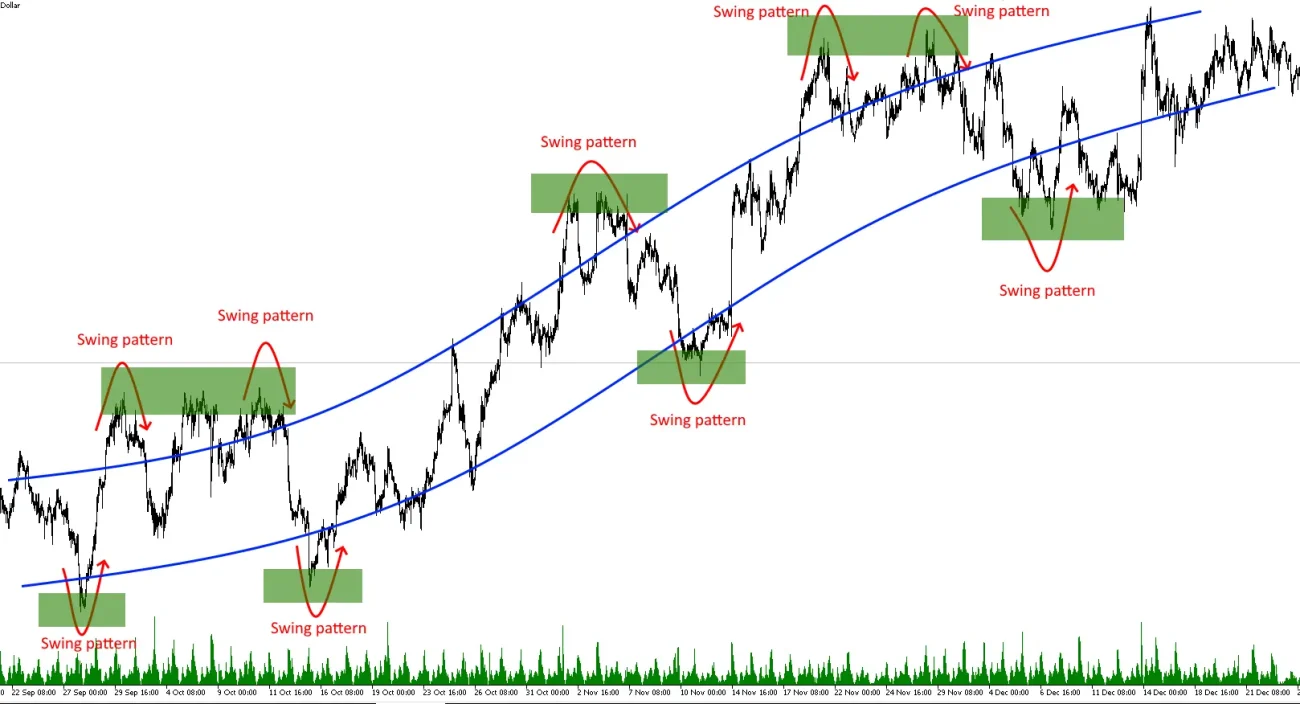
Makes trades in accordance with the swing trading strategy
When the trading bot finds all the conditions specified by the neural network, it makes trading operations and fixes the profit at the level of the axial gravitational moving average around which the price rotates.
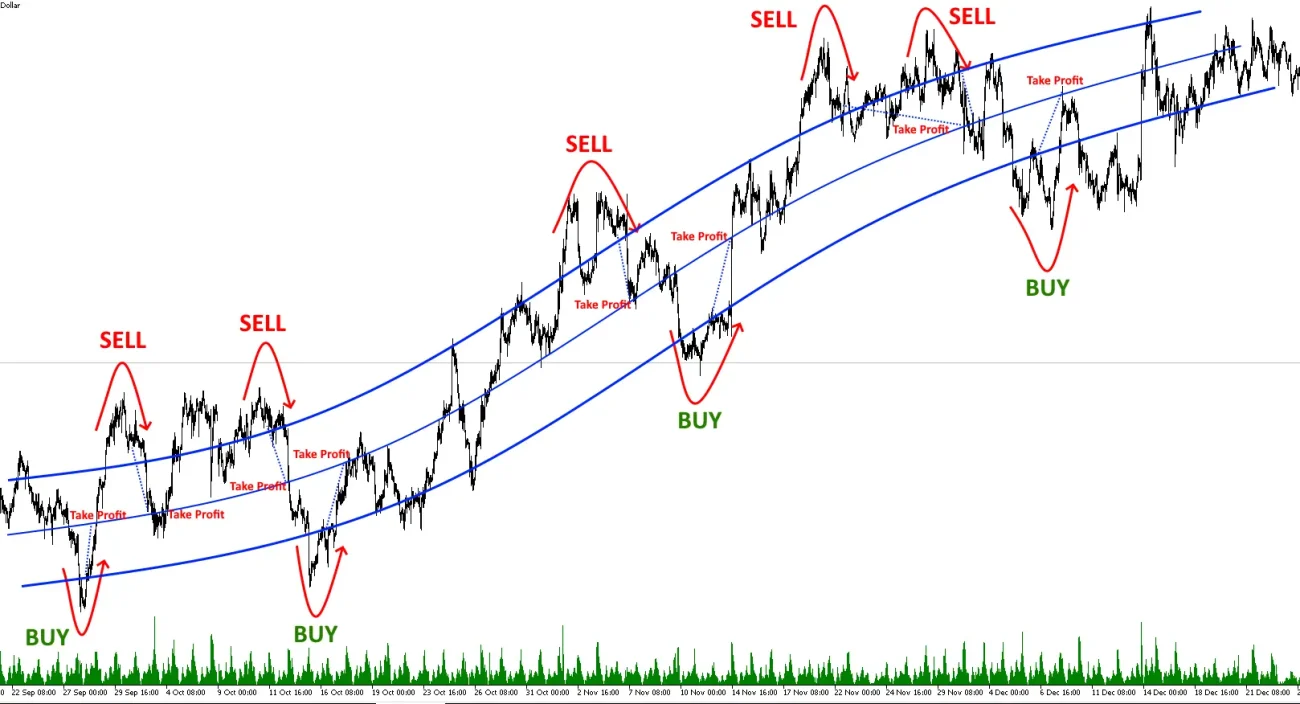
Choose the strategy you like
You can choose any of these trading strategies and make money online with this unique automated trading system! Each of the listed systems is based on trading on swing reversals. However, each system uses different money management rules, different numbers of trades, and different rules for using Stop Loss and Take Profit.

Swing Trading System

Trend Trading System

Local Martingale

Reversal Grid System
Reviews from real users
Wow! I am impressed! It works really cool and makes a profit! My trading drawdown is very low - about 2%. I have been using this bot for about 2 months and during this time it has earned 24% profit! Very impressive!
Swing Trade Bot is one of the best software in my collection! A large number of assets in the portfolio and several trading strategies. In simple words - you buy 1 bot and get several at once!
I have a leverage of 1:30. It is very difficult to find a trading bot for such leverage. Martingale and averaging are not suitable. Swing Trade Bot is exactly the software that I have been looking for for a long time. This bot works great on low leverage!
I am very glad that I found this site and this bot! This is the best trading decision in 2024! This is TOP 1 in my rating! I give it 5 stars! I recommend it to everyone!

AI Swing Trading EA
+6 595 % growth - verified real result
Swing Trading EA is a multi-currency bot (MT4 + MT5) for trading using the Swing Reversal strategy (uses 4 strategies). 10 assets to trade. Verified by MyFxbook. Prop Firm passed.- Swing Trading EA for MT5
- Swing Trading EA for MT4
- Lifetime license without subscription
- The number of licenses is unlimited
- Settings (set files) for maximum performance
- Detailed instruction – how to install and use
- Technical support
Here we will answer questions that you may have after viewing this page:
Automated trading, also known as algorithmic trading, refers to the use of computer algorithms and software to execute trades in the financial markets with minimal human intervention. This technology allows trades to be carried out at speeds and frequencies that are beyond the capability of manual trading. The core idea behind automated trading is to capitalize on market opportunities in real-time with a level of precision and consistency that is difficult to achieve through manual processes.
The process begins with the development of trading strategies, which are based on mathematical models and statistical analysis of market data. These strategies are then coded into algorithms that can automatically monitor the markets for specific conditions or signals. When these conditions are met, the algorithms execute buy or sell orders on behalf of the trader.
Automated trading systems can vary in complexity, from simple strategies that execute trades based on basic indicators, to highly sophisticated systems that utilize artificial intelligence and machine learning to predict market movements. These systems can be programmed to adjust to changing market conditions, manage risks, and execute trades across multiple accounts and various instruments simultaneously.
One of the key advantages of automated trading is its ability to eliminate emotional decision-making and human error from the trading process. By adhering strictly to predefined rules, these systems can make objective decisions based on data alone. Additionally, automated trading can enhance efficiency and reduce transaction costs, as trades can be executed more quickly and at optimal prices.
However, automated trading also comes with its challenges, such as the potential for technical failures and the need for continuous monitoring to ensure that systems are operating as intended. Moreover, the use of complex algorithms can sometimes result in unpredictable market behavior, especially during volatile conditions.
Overall, automated trading has transformed the landscape of financial markets, making it possible for both institutional and retail traders to leverage technology for improved trading performance. As technology continues to evolve, the sophistication and adoption of automated trading systems are expected to increase, further shaping the future of trading.
Swing trading is a trading strategy used in the financial markets that aims to capture short- to medium-term gains in a stock (or any financial instrument) over a period of a few days to several weeks. Swing traders utilize technical analysis to look for stocks with short-term price momentum. They may also consider the underlying fundamentals of the stocks or the overall market conditions to enhance their strategy. The core idea behind swing trading is to identify where an asset's price is likely to move next and enter trades based on this prediction, holding the position until the trend starts to reverse or their profit targets are reached.
Unlike day traders, who might make multiple trades within a single day, swing traders typically hold positions for several days or weeks, aiming to capture a significant portion of a potential price move. The longer holding period gives the asset more time to undergo the desired price movement, making swing trading an attractive option for those who cannot monitor the markets every moment of the trading day but still wish to actively participate in the markets.
Swing trading strategies often rely on technical indicators to identify potential entry and exit points. These indicators can include moving averages, relative strength index (RSI), stochastic oscillators, and others. Swing traders look for patterns and signals such as support and resistance levels, trend lines, and price action to make trading decisions.
One of the key advantages of swing trading is the balance it offers between the fast-paced nature of day trading and the long-term approach of buy-and-hold investing. It provides traders the opportunity to benefit from market trends without the need to constantly monitor their trades. However, like all trading strategies, swing trading involves risk, particularly from market volatility and gaps in price movement that can occur between trading sessions.
Effective swing trading requires a solid understanding of market trends, the ability to conduct thorough technical analysis, and the discipline to adhere to a trading plan. It also requires careful risk management, including the use of stop-loss orders to protect against large losses.
In summary, swing trading is a strategy that seeks to take advantage of short- to medium-term price movements in financial markets. By leveraging technical analysis and maintaining a disciplined approach, swing traders aim to generate profits over a period of days to weeks, making it a popular choice among individual traders looking for a balance between the intensive demands of day trading and the long-term commitment of traditional investing.
Day trading is a trading strategy employed in the financial markets where individuals buy and sell financial instruments within the same trading day. This means all positions are closed before the market closes for the trading day. The goal of day trading is to make profits from the short-term price movements of stocks, currencies, futures, and other financial instruments. Day traders capitalize on the volatility during the trading day, taking advantage of small price movements that occur within minutes or hours.
Day trading is characterized by high speed and high risk, as it involves making quick decisions to buy or sell based on minute-to-minute market changes. Traders use a variety of strategies and technical analysis tools to predict price movements and identify trading opportunities. These strategies can include scalping (making many small trades for small price gains), range trading (buying at the low end of a range and selling at the high end), and momentum trading (buying in markets moving up and selling in markets moving down).
One of the key aspects of day trading is the use of leverage, which allows traders to control large positions with a relatively small amount of capital. While leverage can significantly increase profits, it also increases the potential for large losses, making risk management crucial in day trading. Traders must be disciplined, setting strict stop-loss orders and profit targets to protect their capital.
Day trading requires a comprehensive understanding of the markets, including how different factors like economic indicators, corporate news, and market sentiment can affect prices. Traders need to stay informed about market conditions, monitor their trades closely, and be ready to act quickly to adjust their positions.
Due to its risky nature, day trading is not suitable for everyone. It demands a significant amount of time, focus, and dedication, as traders need to monitor the markets throughout the trading day. Additionally, day trading can be stressful, given the fast-paced decision-making process and the potential for significant financial loss.
Successful day traders often have a deep knowledge of the markets, solid trading strategies, and strict discipline in following their trading plan. They also need to be comfortable with taking risks and dealing with the psychological pressures that come with rapid trading decisions.
In summary, day trading is a speculative trading strategy focused on making profits from short-term price movements within the same trading day. It requires quick decision-making, a thorough understanding of market dynamics, and stringent risk management practices. While it offers the potential for high returns, it comes with a high level of risk and is best suited for experienced traders who can afford the potential financial and emotional costs.


